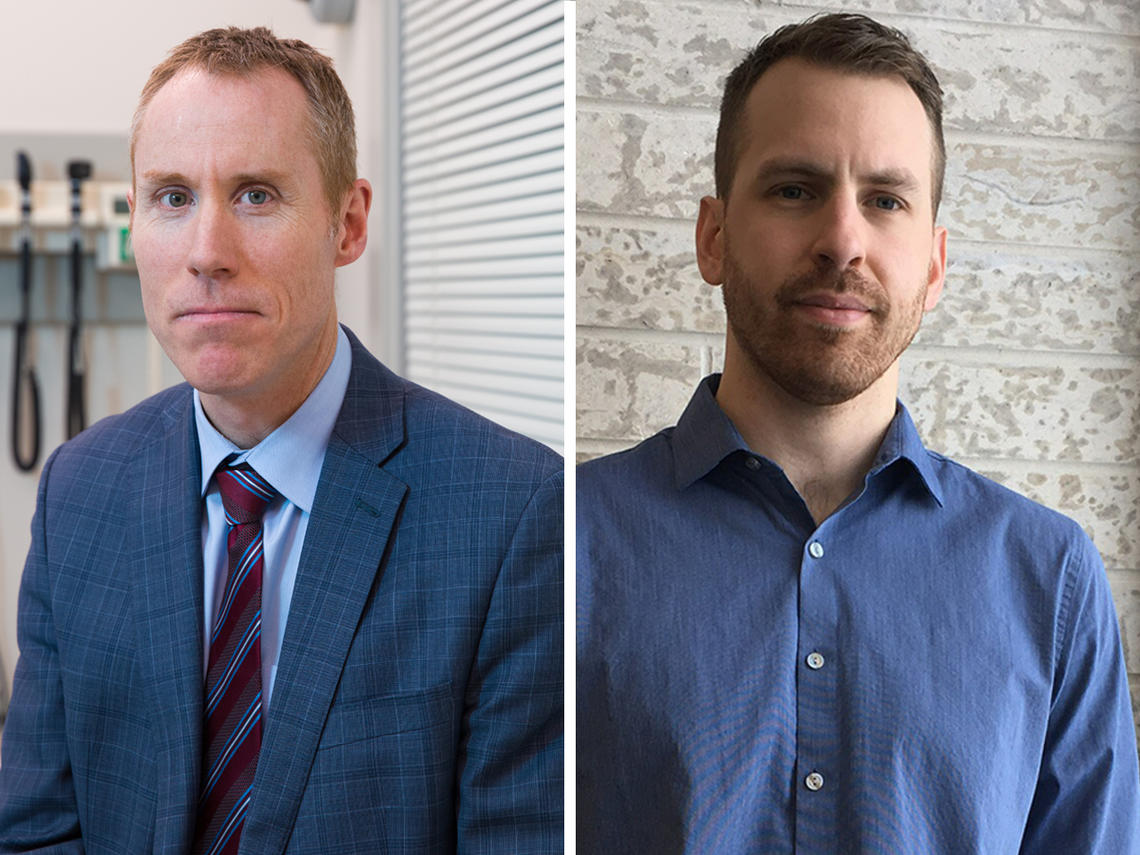Jan. 24, 2017
Medical assistance in dying will not increase health-care costs in Canada

Dr. Braden Manns, left, and Dr. Aaron Trachtenberg, co-authors of the new study.
University of Calgary
Canada’s recent legalization of medical assistance in dying has meant that health systems have to adapt to provide this service. A new study in the Canadian Medical Association Journal estimates that the direct cost of providing this service will range from $1.5 to $14.8 million annually, excluding the cost of services required for program administration and co-ordination. However, in this study, the authors estimated that the use of medical assistance in dying would reduce overall spending by between $34.7 and $138.8 million annually. The authors caution that cost reduction should not be a factor in individual decision-making by patient and physicians though.
“We are not suggesting medical assistance in dying as a measure to cut costs,” write Drs. Aaron Trachtenberg and Braden Manns, University of Calgary, Cumming School of Medicine. “At an individual level, neither patients nor physicians should consider costs when making the very personal decision to request, or provide, this intervention.”
Health-care costs escalate during last six months of life
Health-care costs increase as people near death and take a greater portion of health care. For example, in the province of Manitoba, data indicates that 20 per cent of health-care costs are allocated to patients in the last six months of life, although they make up only one per cent of the population.
The researchers combined data from the Netherlands and Belgium — where medically assisted dying is legal — with recent data on end-of-life costs in Canada, to estimate the impact of this recently introduced option on health-care spending. In their modelling, the researchers estimated between one and four per cent of all deaths would be medically assisted, and that 80 per cent would be cancer patients — of whom 50 per cent would be aged 60 to 80 years. Of these patients, 60 per cent would die one month earlier and 40 per cent would die one week earlier than without medically assisted dying.
Cost of assisted dying determined using four models
To estimate costs of assisted dying, the researchers ran four different models based on one, two, three and four per cent of deaths and created subgroups based on sex, age and average cost of health care use in the last month and last week of life for each subgroup.
The authors note a limitation of using data from the Netherlands and Belgium as assisted dying is allowed for minors, people with dementia and non-terminal diseases in those countries. In Canada, medically assisted dying is only available to adults aged 18 years and over and whose death is fairly imminent. As well, the cost data was from the province of Ontario, and may not represent all end-of-life spending in Canada.
“The true effect on health-care costs will not be certain until we determine who the typical Canadian patient requesting the intervention is and how its practice is implemented across the country,” the authors write.
Need for further patient-level research
“Our analysis is only a cost analysis and does not consider the clinical effects of medical assistance in dying on patients at the end of life,” write the authors. “Patient-level research that explores the reasons why Canadians choose medical assistance in dying, the value they assign to their suffering versus death and other aspects of their experience will need to be completed before a full economic evaluation of medical assistance in dying can be done.”
In a related commentary , Dr. Peter Tanuseputro, a physician at Bruyere Research Institute and the Ottawa Hospital Research Institute, writes that Canada should improve palliative care to improve end-of-life care.
“These potential cost savings, which are not trivial, should be considered in the context of the largely inadequate and haphazard delivery of palliative care across Canada,” he writes. “Despite some successful and exemplary palliative care programs, palliative care in Canada remains deficient; this is the reason that aggressive, institution-based and ultimately costly end-of-life care exists, and why such a large potential cost savings can be anticipated from medical assistance in dying in Canada.”
Large potential cost savings anticipated
Transforming palliative care will improve quality of life for dying patients by alleviating suffering. “What matters most is that we address society’s failure to provide adequate care for the dying,” he concludes.
Braden Manns is a professor in the departments of Community Health Science and Medicine. He is member of the Libin Cardiovascular Institute of Alberta and O’Brien Institute for Public Health, at the Cumming School of Medicine.
Aaron Trachtenberg is a resident in internal medicine at the Cumming School of Medicine.
The Canadian Medical Association Journal contributed to this article.
